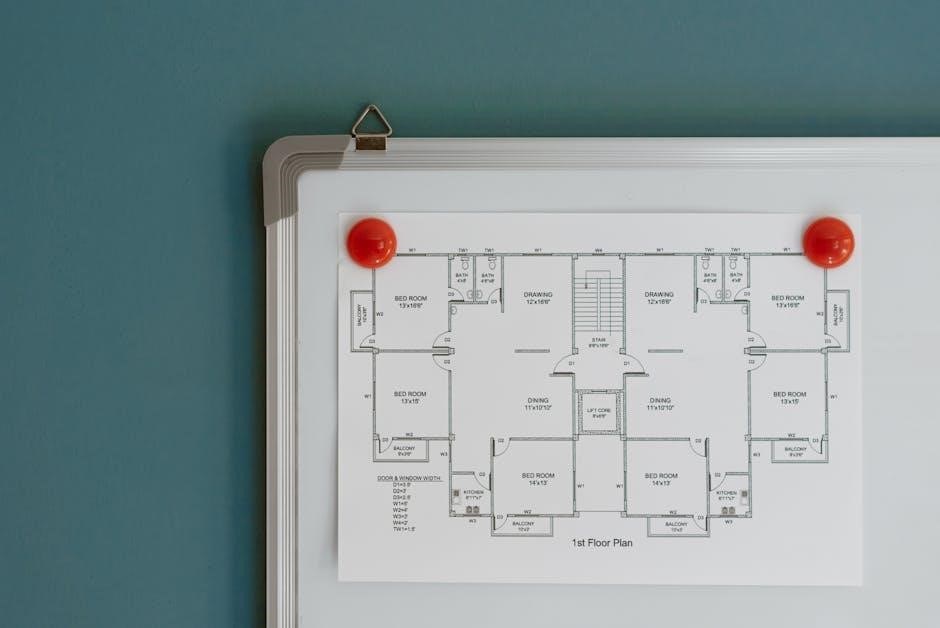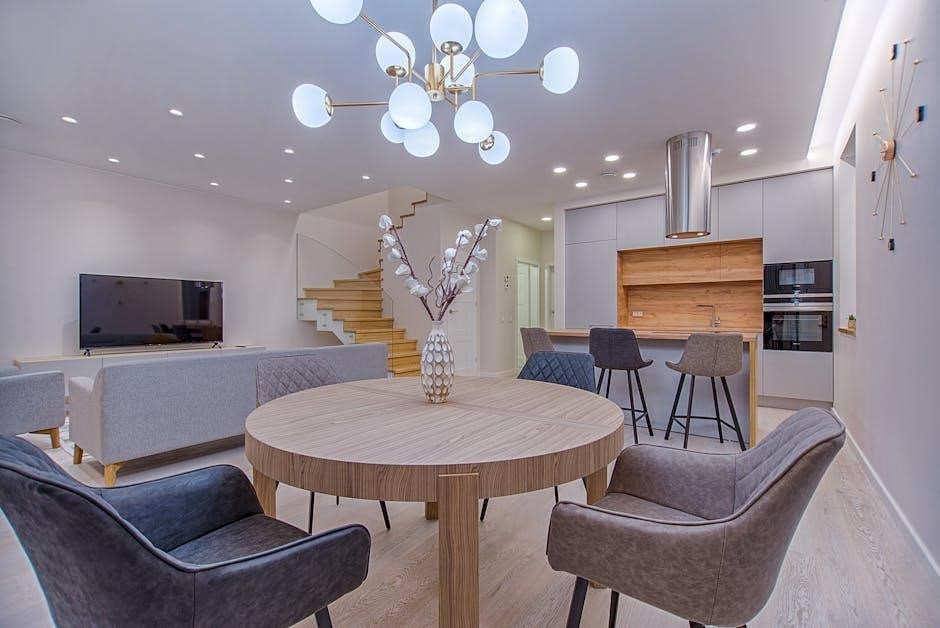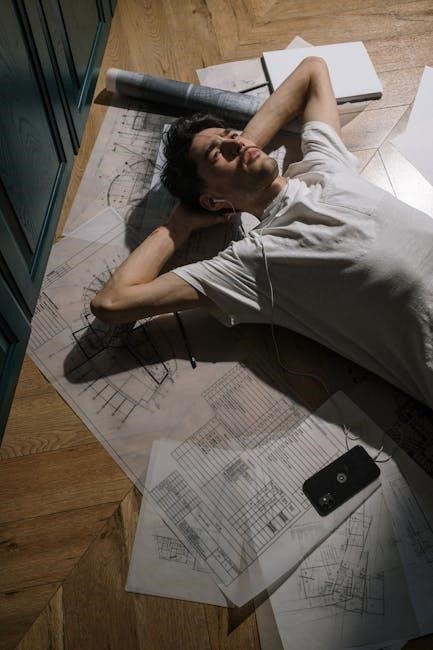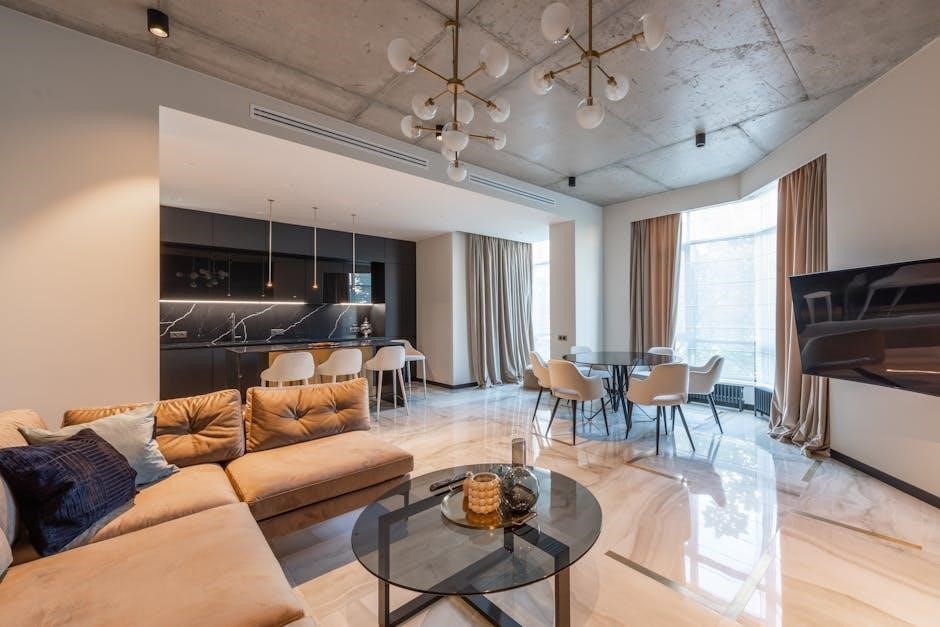A PDF floor plan is a digital, scalable representation of a building’s layout, offering precision and clarity for architecture, design, and visualization across various industries.
What is a PDF Floor Plan?
A PDF floor plan is a digital representation of a building’s layout, created using design software like EdrawMax or Canva. It is a scalable and precise document that showcases rooms, walls, doors, and windows in a structured format. Unlike standard images, PDF floor plans retain their quality when zoomed in or out, making them ideal for construction planning, interior design, and real estate presentations. They are widely used in architecture and design industries due to their clarity and versatility. PDF floor plans can also include measurements, symbols, and furniture layouts, making them a comprehensive tool for visualizing spaces. Their digital format allows easy sharing and editing, ensuring collaboration and accuracy in projects.

Importance of PDF Floor Plans in Architecture and Design
PDF floor plans play a crucial role in architecture and design by providing precision and clarity in visualizing spaces. Their scalability ensures they remain clear at any zoom level, making them ideal for construction planning, presentations, and real estate. Architects and designers rely on PDFs for their ability to retain quality when printed or shared digitally, ensuring consistency across teams. They facilitate collaboration by allowing easy modifications and annotations, streamlining communication between stakeholders. Additionally, PDF floor plans are essential for creating detailed interior designs, as they can include measurements, symbols, and furniture layouts. Their versatility and accuracy make them a cornerstone in modern architectural workflows, enabling professionals to deliver high-quality projects efficiently.
Common Uses of PDF Floor Plans
PDF floor plans are widely used in various industries for their versatility and clarity. In real estate, they help agents and buyers visualize property layouts. Homeowners use them for remodeling projects to plan renovations effectively. Architects and designers utilize PDFs to present precise plans to clients and stakeholders. Contractors rely on them for accurate measurements and spatial understanding. Facility managers employ PDF floor plans for space planning and maintenance scheduling. Interior designers use them to conceptualize and share furniture layouts. Additionally, PDF floor plans are essential for 3D visualization, allowing users to explore spaces digitally. Their scalability and high-quality output make them ideal for printing and sharing in professional settings. Overall, PDF floor plans are indispensable tools for communication, planning, and execution in architecture, design, and related fields.

Tools and Software for Creating PDF Floor Plans
Popular tools like EdrawMax, Canva, Adobe Illustrator, Planner 5D, Microsoft Visio, and ConceptDraw DIAGRAM offer intuitive features for designing and exporting precise, professional PDF floor plans efficiently.
Popular Software for Designing Floor Plans
EdrawMax, Canva, Adobe Illustrator, Planner 5D, Microsoft Visio, and ConceptDraw DIAGRAM are widely used for creating PDF floor plans. EdrawMax offers templates and symbols for quick designs, while Canva provides user-friendly tools for non-designers. Adobe Illustrator is ideal for advanced editing and precision. Planner 5D supports 2D and 3D visualizations, making it versatile for both simple and complex layouts. Microsoft Visio is preferred for professional-grade designs with precise scaling and alignment features. ConceptDraw DIAGRAM is a great option for macOS users, offering intuitive tools for modifying and enhancing floor plans. These software options cater to various needs, from basic layouts to detailed, scalable designs, ensuring high-quality output for architectural and interior design projects.
EdrawMax as a Floor Plan Creator
EdrawMax is a powerful tool for creating detailed and precise PDF floor plans. It offers a wide range of templates, symbols, and intuitive tools, making it easy to design both 2D and 3D layouts. Users can start by selecting a template or creating a plan from scratch, then customize it with walls, doors, windows, and furniture. The software supports precise scaling, ensuring accuracy for professional-grade designs. EdrawMax also allows users to export their floor plans in various formats, including PDF, for easy sharing and printing. Its user-friendly interface and extensive library of design elements make it a popular choice for architects, designers, and homeowners alike, providing a seamless experience for creating and editing floor plans.
Using Canva for Custom Floor Plans
Canva offers a user-friendly platform for designing custom floor plans, even for those without advanced design skills. To create a floor plan on Canva, simply open the platform and select a floor plan template from the available options. These templates are customizable, allowing users to add walls, doors, windows, and furniture to suit their needs. The drag-and-drop interface makes it easy to modify layouts and experiment with different designs; Once the design is complete, it can be saved, shared, or exported as a PDF, making it ideal for both personal and professional use. Canva’s intuitive tools and extensive design options provide a flexible solution for creating detailed and visually appealing floor plans in a straightforward manner.
Adobe Illustrator for Advanced Floor Plan Editing
Adobe Illustrator is a powerful tool for advanced floor plan editing, offering precise vector-based design capabilities. Users can import PDF floor plans and edit them with high accuracy, leveraging Illustrator’s robust set of tools. The software allows for scaling, aligning, and modifying elements like walls, doors, and windows with great detail. Layers can be used to organize design elements, making it easier to manage complex layouts. Additionally, Illustrator supports the addition of overlays, such as telecom diagrams, to enhance the floor plan’s functionality. With its advanced features, Illustrator is ideal for professionals seeking to create highly customized and detailed floor plans, which can then be exported as PDFs for sharing or further use.
Planner 5D for 3D and 2D Floor Plans
Planner 5D is a versatile tool that excels in creating both 2D and 3D floor plans, offering a seamless design experience. Users can easily generate detailed layouts, customize spaces, and visualize rooms in three dimensions. The software is user-friendly, allowing even beginners to create professional-looking floor plans. One of its standout features is the ability to add precise measurements, ensuring accuracy in the design. Planner 5D also supports exporting floor plans as PDFs, making it easy to share or print them. This tool is particularly useful for interior designers, architects, and homeowners looking to visualize and plan spaces effectively. Its combination of 2D and 3D capabilities makes it a comprehensive solution for floor plan creation and editing.

Microsoft Visio for Professional Floor Plans
Microsoft Visio is a powerful diagramming tool that excels in creating professional floor plans. With a wide range of templates and symbols, users can design detailed and accurate layouts. Visio allows for precise scaling, ensuring that floor plans are proportionate and easy to understand. Its intuitive interface makes it accessible for both professionals and non-designers. One of its key features is the ability to export floor plans as PDFs, images, or CAD files, making it easy to share and collaborate. Visio is particularly popular among architects, designers, and businesses for its versatility and integration with other Microsoft tools. Whether for commercial or residential projects, Visio provides a reliable solution for creating and editing professional-grade floor plans with ease.
ConceptDraw DIAGRAM for macOS Users
ConceptDraw DIAGRAM is a versatile tool designed specifically for macOS users, offering robust features for creating and editing PDF floor plans. It allows users to import existing PDF floor plans, make modifications, and add detailed overlays such as telecom diagrams. The software is ideal for both professionals and amateurs, providing an intuitive interface for designing precise and scalable layouts. With its ability to work seamlessly on macOS, ConceptDraw DIAGRAM is a great choice for users who need to visualize and edit floor plans with ease. Its compatibility with macOS ensures smooth integration with other tools and workflows, making it a reliable option for anyone looking to enhance their floor plan designs.

Creating a PDF Floor Plan from Scratch
Creating a PDF floor plan from scratch involves designing the layout from a blank canvas, adding walls, doors, and windows, then customizing with furniture and symbols for precision.
Step 1: Choosing the Right Template

Selecting the appropriate template is crucial for creating an accurate and visually appealing PDF floor plan. Templates provide pre-designed layouts for various spaces, such as residential homes, offices, or commercial areas, saving time and ensuring consistency. When choosing a template, consider the specific type of floor plan you need, such as a 2D or 3D layout, and ensure it aligns with your project’s requirements. Many software tools, like EdrawMax or Microsoft Visio, offer a wide range of templates to suit different needs. Using a template helps establish a foundation for your design, allowing you to focus on customization rather than starting from scratch. This step ensures your floor plan is both professional and functional.
Step 2: Setting the Scale for Accuracy
Setting the correct scale is essential for ensuring accuracy in your PDF floor plan. Floor plans are not drawn to a 1:1 scale but use a scaling factor to fit the design on a page. Common scales include 1:50, 1:100, or 1:200, depending on the project size. To set the scale, use software tools like EdrawMax or Microsoft Visio, which allow you to define measurements precisely. Aligning the drawing scale ensures that all elements, such as walls, doors, and furniture, are proportionate and measurable. This step is critical for maintaining consistency and ensuring that the floor plan can be used effectively for construction, interior design, or visualization purposes. Accurate scaling also enables precise printing and sharing of the plan in various formats.
Step 3: Drawing Walls and Basic Layout
After setting the scale, the next step is to draw the walls and basic layout of your floor plan. Start by placing the original plan as a PDF or image in the background with reduced opacity (around 50%) and lock it to use as a reference. Using tools like EdrawMax or Canva, begin drawing walls, ensuring they align with the reference image. Pay attention to corners and intersections to maintain accuracy. Use grid snapping or alignment features to keep elements straight and neatly organized. This foundational layout serves as the framework for adding details like doors, windows, and furniture later. Keeping the walls and layout precise ensures the rest of the design process flows smoothly and maintains scalability for both digital and physical use.
Step 4: Adding Doors, Windows, and Openings
Once the walls are drawn, the next step is to add doors, windows, and openings. Use tools like EdrawMax or Canva to insert these elements, ensuring they align with the reference plan. Doors and windows should be placed accurately, considering their size and orientation. Use symbols or shapes provided by the software to represent these features. For openings, such as stairwells or skylights, use customizable shapes or draw them manually. Layers can help organize these elements, keeping the design clean. Ensure all additions are to scale and properly aligned with the walls. This step enhances the functionality and aesthetics of the floor plan, making it more detailed and realistic for visualization or presentation purposes. Precision here is key for maintaining the plan’s accuracy and usability.
Step 5: Customizing with Furniture and Symbols
After setting up the basic layout, customize your PDF floor plan by adding furniture and symbols to enhance its functionality and aesthetics. Use built-in libraries in tools like EdrawMax or Canva to drag-and-drop furniture icons, such as sofas, beds, or desks, into your design. Symbols for electrical outlets, lighting fixtures, and plumbing can also be added for greater detail. Arrange furniture to reflect real-world layouts, ensuring proper spacing and alignment with walls and doors. These elements make the floor plan more interactive and visually appealing, aiding in interior design decisions. Additionally, symbols help clarify the purpose of each room and its features, making the plan more informative for users. This step transforms a basic floor plan into a comprehensive and actionable design tool.
Step 6: Finalizing the Design
Once all elements are in place, review your PDF floor plan for accuracy and consistency. Ensure walls, doors, windows, and furniture are correctly positioned and aligned. Check the scale to confirm measurements are precise. Use software tools like EdrawMax or Adobe Illustrator to fine-tune details, adjust layers, and ensure all symbols are properly annotated. Verify that the layout reflects the intended space accurately. Make any final adjustments to furniture placement or design elements for aesthetic appeal. Proofread labels and annotations to avoid errors. This step ensures the floor plan is professional, clear, and ready for sharing or printing. A well-finalized design enhances collaboration and communication in architectural and interior design projects.
Step 7: Exporting the Plan as a PDF
Once your floor plan is finalized, export it as a PDF to ensure compatibility and professionalism. Most design tools like EdrawMax, Canva, or Adobe Illustrator offer a direct export option. Select the appropriate settings, such as resolution and page size, to maintain clarity. Ensure all layers are visible and properly aligned before exporting. Choose a file name that reflects the project or location for easy identification. After exporting, review the PDF to confirm that all elements, including text and symbols, are legible. This step ensures your floor plan is ready for sharing, printing, or further collaboration. Exporting as a PDF is the ideal format for preserving your design’s integrity across different devices and software.

Editing and Customizing PDF Floor Plans
PDF floor plans can be imported, scaled, and customized using tools like Adobe Illustrator or ConceptDraw DIAGRAM. Layers and overlays enable precise modifications to walls, doors, and layouts.
Importing a PDF Floor Plan for Modifications
Importing a PDF floor plan allows for easy modifications using tools like Adobe Illustrator or ConceptDraw DIAGRAM. Start by placing the PDF as a background layer at 50% opacity and locking it. This ensures the original layout remains intact while enabling precise edits. Use layers to organize new elements, such as walls, doors, and windows, ensuring clarity and avoiding overlaps. Scale the drawing accurately to maintain proportions, and add overlays like telecom diagrams or furniture symbols for enhanced customization. This method simplifies the editing process, making it easier to visualize and implement changes. It also ensures that modifications are clear and professional, ready for sharing or further collaboration.
Aligning the Drawing Scale for Accuracy
Aligning the drawing scale ensures precision in PDF floor plans. Since floor plans are not drawn to life size, they use a scaling factor to fit on a page. By setting the scale accurately, measurements remain consistent, and the plan is easy to interpret. Use reference points, such as wall lengths or door widths, to adjust the scale in your software. This step is crucial for maintaining proportions and ensuring that printed copies are to scale. Accurate scaling is essential for professionals like architects and designers to communicate their vision effectively. It also helps in making precise modifications and additions to the layout, ensuring the final design meets practical and aesthetic requirements. Proper scaling is the foundation of a functional and professional floor plan.
Using Layers to Organize Design Elements
Utilizing layers in PDF floor plans enhances organization and simplifies modifications. Layers allow users to categorize elements like walls, furniture, and annotations separately, reducing clutter and improving clarity. This feature is particularly useful when collaborating, as different teams can focus on specific aspects without interfering with others. By isolating elements, changes can be made efficiently, and visibility of details can be toggled as needed. For instance, structural elements can be placed on one layer, while decorative elements like furniture can be on another. Layers also facilitate precise editing, ensuring that modifications are accurate and targeted. This organizational tool is essential for maintaining a clean and professional design, especially in complex projects. Proper use of layers streamlines the design process and enhances overall productivity. It is a key feature for achieving a well-structured and visually appealing floor plan.
Adding Telecom Diagrams Overlays
Incorporating telecom diagrams into PDF floor plans allows for the integration of network infrastructure, such as cables, routers, and switches, directly onto the building layout. This overlay provides a comprehensive view of both physical spaces and technological systems. By placing telecom elements on a separate layer, users can easily toggle their visibility without disrupting the main design; This feature is crucial for planning network installations and ensuring seamless connectivity. It also aids in identifying potential issues, such as cable routing conflicts or coverage gaps. The ability to visualize telecom components alongside architectural elements streamlines communication between IT and design teams. This integration is vital for modern buildings, where efficient network planning is essential. The overlay ensures that all systems are optimized for functionality and aesthetics, making it an indispensable tool for contemporary design projects. It bridges the gap between physical and digital infrastructure seamlessly.
Modifying Walls, Doors, and Windows
Modifying walls, doors, and windows in a PDF floor plan involves precise editing to ensure accuracy and functionality. Start by importing the PDF and aligning the drawing scale to maintain consistency. Use layers to organize elements, allowing easy access to specific components. For walls, adjust their thickness or reposition them as needed. Doors and windows can be resized or relocated to suit design requirements. Utilize snapping tools to align elements perfectly. After modifications, lock layers to prevent accidental changes. These adjustments enhance the plan’s clarity and ensure it reflects the intended space accurately. Regularly save your work to avoid data loss. This process is essential for creating detailed and functional floor plans tailored to specific needs. It ensures that every element is correctly proportioned and positioned, providing a clear visual representation of the space. This step is crucial for both new designs and existing plan updates.

Advanced Features of PDF Floor Plans
Advanced features include scaling for precision, 3D visualization, and printing to scale. Adding furniture enhances interior design, while overlays like telecom diagrams improve functionality and detail.
Scaling and Precision in Floor Plans
Scaling is essential for accuracy in PDF floor plans, as they are not drawn to scale. Instead, they use scaling factors to fit on a page. This ensures that measurements are consistent and proportional, allowing precise adjustments. Tools like EdrawMax and Canva enable users to set and adjust scales easily. Proper scaling ensures that the floor plan reflects real-world dimensions accurately, making it easier to visualize and implement designs. Whether for construction, remodeling, or interior design, precise scaling is critical for achieving the desired outcome. It also supports 3D visualization and printing to scale, ensuring compatibility across different formats and applications.

3D Visualization of PDF Floor Plans
3D visualization transforms PDF floor plans into immersive, interactive models, enhancing understanding and design exploration. Tools like Planner 5D and EdrawMax allow users to convert 2D layouts into 3D with ease. This feature is invaluable for architects, designers, and homeowners to visualize spaces accurately. 3D models enable better planning, furniture placement, and spatial analysis. They also facilitate communication among stakeholders by providing a realistic preview of the final design. Additionally, 3D visualization supports virtual walkthroughs, making it easier to identify potential issues before construction begins. This capability bridges the gap between abstract plans and tangible results, offering a dynamic way to experience and refine designs.
Printing to Scale for Physical Copies
Printing PDF floor plans to scale ensures accurate physical representations for construction, planning, and presentation. Tools like Planner 5D and EdrawMax enable precise scaling, allowing users to adjust measurements before printing. This feature is crucial for maintaining the integrity of architectural designs. By exporting the floor plan as a PDF or image, users can print it on various paper sizes while preserving the correct proportions. Accurate scaling ensures that distances and dimensions remain consistent, making it easier to visualize and execute projects. Physical copies are essential for on-site references, client meetings, and ensuring everyone involved has a clear understanding of the layout. Printing to scale is a vital step in transforming digital designs into tangible, actionable plans.
Adding Furniture for Interior Design
Adding furniture to PDF floor plans enhances interior design visualization, allowing users to see how spaces will look with specific layouts. Tools like Planner 5D and EdrawMax offer libraries of furniture symbols and objects that can be easily dragged and dropped onto the floor plan. This feature is particularly useful for interior designers and homeowners to experiment with different configurations. By customizing the placement of furniture, users can optimize space usage and create functional, aesthetically pleasing environments. The ability to add furniture transforms a basic floor plan into a detailed, realistic representation of a living or working space, making it easier to communicate design ideas effectively. This functionality bridges the gap between architectural planning and interior design, providing a comprehensive view of a space’s potential.

Sharing and Collaboration
PDF floor plans can be exported as PDF, image, or CAD files, shared via links, or collaborated on using cloud tools for efficient teamwork and feedback.
Exporting Files as PDF, Image, or CAD
Exporting floor plans as PDF, image, or CAD files allows for universal compatibility and flexibility. PDFs are ideal for sharing detailed layouts with clients, preserving vector graphics for crisp scaling. Images, such as PNG or JPEG, are useful for web sharing or presentations. CAD formats enable further editing in specialized software like AutoCAD or Revit, making them essential for professionals. Many tools, including Canva, Adobe Illustrator, and Planner 5D, offer direct export options. This versatility ensures that floor plans can be accessed, edited, or printed effortlessly, catering to different needs and workflows. Exporting in multiple formats enhances collaboration and adaptability across various platforms and industries, making PDF floor plans a versatile and practical choice for architects, designers, and planners.
Sharing Floor Plans via Links
Sharing floor plans via links is a convenient and efficient way to collaborate with clients and teams. Platforms like Canva, Planner 5D, and other design tools allow users to generate shareable links for their PDF floor plans. This feature enables real-time access and editing, eliminating the need for email attachments. Recipients can view or comment on the plans directly through the link, streamlining communication. Additionally, some tools offer password protection and access controls for secure sharing. This method is particularly useful for remote teams and ensures that everyone has the most up-to-date version. By sharing links, professionals can easily manage feedback and revisions, making the design process faster and more organized. This approach also reduces the risk of version control issues, ensuring clarity and accuracy in collaborations.
Collaborating with Teams Using Cloud Tools
Cloud-based tools have revolutionized team collaboration on PDF floor plans, enabling real-time editing and feedback. Platforms like Planner 5D, Canva, and ConceptDraw DIAGRAM offer cloud solutions where teams can access and modify floor plans simultaneously. These tools provide features such as comment sharing, version tracking, and synchronized updates, ensuring everyone stays on the same page. Cloud collaboration eliminates the need for multiple file versions, reducing errors and saving time; Team members can contribute from anywhere, making it ideal for remote work. Additionally, cloud tools often include secure sharing options, such as password-protected links, to ensure only authorized users can edit or view the plans. This seamless integration enhances productivity and fosters effective communication among architects, designers, and clients. Cloud-based collaboration is now a cornerstone of modern floor plan design workflows.



